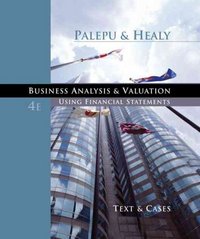FIRM IS THE COMPANY CLOROX



1) Accounting Component a) Obtain the most recent ten years of annual total sales (total revenue) data from the firm's financial history. In addition, use just the last three years for the firm's financial statement data: I recommend, you use abbreviated financial statements. They can be found in Nasdaq.com, Yahoo Finance, MSN Money. DO NOT GET BOGGED DOWN IN THE DETAILED OF THE AGGREGATE FINANCIALS i) Income Statement ii) Balance Sheet iii) Statement of Cash Flow b) Derive common size statements for the income statement and the balance sheet NOT the cash flow i) Looking at trends in the data ii) Looking at variations in the same data as well as variations in the trends 2) General Component a) No more than one paragraph describing the history and industry of the company. 3) Economic Component a) How does the above relate to the industry that the company is in, i.e. need to perform competitive economic analysis about the company: i) Macroeconomic analysis----is the company's sales cyclical or counter cyclical for example? ii) Industry analysis---market share. Are the company's sales growing, declining, or staying the same? How is the company performing relative to its competition? 4) SWOT a) STRENGTHS and WEAKNESSES should focus EXCLUSIVELY on the INTERNAL CHARACTERISTICS OF THE FIRM'S FINANCES. b) The OPPORTUNITIES and THREATS should focus EXCLUSIVELY on the EXTERNAL CHARACTERISTICS OF THE FIRM'S FINANCES. 5) Trends and Deviations in the company's historical data 6) Finance Component a) The PERCENT OF SALES MODEL and the above should provide you the assumptions for deriving proformas for each of the three financial statements (balance sheet, income statement, and statement of cash flow), and will allow you to do your critical financial analysis of the firm. i) The pro forma, must be forecasted out three years. ii) Make sure you focus on your assumptions and EXPLICITLY show them since they will drive your forecasted data, which will allow you to perform the critical analysis where the company is going, based on your forecasted data INCLUDING THE FORECASTED SHARE PRICES. iii) This should be the focus of your written analysis; stated differently, the focus needs to be on the future of your company and where it is going and why. b) The emphasis should not be on the history of the company, other than what I have asked you to include, that is stated above. c) Finally, in your analysis you need to justify your conclusions. For example, is the company in a strong financial position based on its EXPECTED SHARE PRICES and MARKET CAPITALIZATION? Why or why not? What direction does the company need to go in either case? These are some of the questions that need answered. 1) Accounting Component a) Obtain the most recent ten years of annual total sales (total revenue) data from the firm's financial history. In addition, use just the last three years for the firm's financial statement data: I recommend, you use abbreviated financial statements. They can be found in Nasdaq.com, Yahoo Finance, MSN Money. DO NOT GET BOGGED DOWN IN THE DETAILED OF THE AGGREGATE FINANCIALS i) Income Statement ii) Balance Sheet iii) Statement of Cash Flow b) Derive common size statements for the income statement and the balance sheet NOT the cash flow i) Looking at trends in the data ii) Looking at variations in the same data as well as variations in the trends 2) General Component a) No more than one paragraph describing the history and industry of the company. 3) Economic Component a) How does the above relate to the industry that the company is in, i.e. need to perform competitive economic analysis about the company: i) Macroeconomic analysis----is the company's sales cyclical or counter cyclical for example? ii) Industry analysis---market share. Are the company's sales growing, declining, or staying the same? How is the company performing relative to its competition? 4) SWOT a) STRENGTHS and WEAKNESSES should focus EXCLUSIVELY on the INTERNAL CHARACTERISTICS OF THE FIRM'S FINANCES. b) The OPPORTUNITIES and THREATS should focus EXCLUSIVELY on the EXTERNAL CHARACTERISTICS OF THE FIRM'S FINANCES. 5) Trends and Deviations in the company's historical data 6) Finance Component a) The PERCENT OF SALES MODEL and the above should provide you the assumptions for deriving proformas for each of the three financial statements (balance sheet, income statement, and statement of cash flow), and will allow you to do your critical financial analysis of the firm. i) The pro forma, must be forecasted out three years. ii) Make sure you focus on your assumptions and EXPLICITLY show them since they will drive your forecasted data, which will allow you to perform the critical analysis where the company is going, based on your forecasted data INCLUDING THE FORECASTED SHARE PRICES. iii) This should be the focus of your written analysis; stated differently, the focus needs to be on the future of your company and where it is going and why. b) The emphasis should not be on the history of the company, other than what I have asked you to include, that is stated above. c) Finally, in your analysis you need to justify your conclusions. For example, is the company in a strong financial position based on its EXPECTED SHARE PRICES and MARKET CAPITALIZATION? Why or why not? What direction does the company need to go in either case? These are some of the questions that need answered










